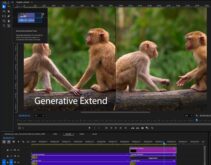Many of the questions I get from readers and see on Web forums relate to confusion about the formats and file types used in the video production process. Briefly, a format defines the file structure, or how the information is presented in the file. Different formats, like the Video for Windows and QuickTime formats, use unique file extensions (AVI and MOV), and different ways of storing the audio, video, and other data contained in the file.
Most programs tend to shield you from this minutiae, but sometimes it really helps to know what’s going on under the hood. The best way to learn these details is to follow the formats through a typical production cycle. Let’s start with what happens inside a DV camcorder. DV camcorders convert information captured through the lens into digital data stored in DV format using the DV codec.
In contrast to a format, a codec is a compression technology, pure and simple. When you capture DV video and store it as an AVI file on a Windows computer (or as an MOV file on a Mac), the computer stores the exact compressed audio/video data received from the camera, changing only format-related stuff like file extension. Accordingly, capturing DV video is more accurately called a file transfer, like copying a file from one computer to another.
Some call this a “lossless” transfer, because no information is lost in the process. Contrast this with capturing video from an analog camcorder, where the video first must be converted from analog to digital format and then compressed for storage on the computer. Both steps involve some “loss” of data, as well as a plethora of confusing settings I’m glad I don’t have to deal with anymore.
However, just because the transfer from DV camera to computer is “lossless” doesn’t mean that the DV codec itself is lossless. Rather, the DV codec uses a stream of frames compressed with JPEG compression, the technology used for most pictures on the Web. JPEG is a “lossy” compression technology, which means that it irrevocably discards information during compression.
The DV codec, however, uses a relatively modest compression ratio of about 5:1, in contrast to 60-70:1 for many web-based pictures. Though this means that the data rate of DV video is high (about 3.6 megabytes per second), it also translates to near-perfect quality. Technically, the DV codec is lossy, but practically, it’s as close to lossless as you can get in a reasonably priced camcorder. Since the DV codec uses a simple sequence of JPEG frames, it’s also easy to process, which means that even low-powered computers can edit DV video with good responsiveness.
Let’s contrast both the quality and editability of DV with another lossy codec/format, MPEG-2, used on some camcorders and video capture devices (mostly external units like the Plextor ConvertX reviewed in the April EMedia [pp.42-43]). While MPEG-2 compression is scalable, the data rate usually ranges from about 1-1.6 megabytes per second. Though much more compact than DV, the immutable rule of lossy compression—the more you compress the more you lose— means that the quality of MPEG-2 video is lower than DV, even at the highest data rate ranges.
In addition, MPEG-2 uses a complicated compression system that is much more difficult for computers to manage during editing. Throw a DV file on a timeline on virtually any computer, and trimming, splitting, and other edits are near instantaneous. Edit an MPEG-2 file on the same computer, and you’ll instantly notice a sluggishness that slows editing significantly.
This highlights the critical distinction between a “capture” codec and a “delivery” codec. The ideal capture codec, DV, captures at the highest possible quality and is responsive on the timeline. The ideal delivery codec provides the best possible quality under the constraints imposed by the delivery system. For example, while definitely second rate as a capture codec, MPEG-2 works well as the delivery codec for DVDs.
What lessons can we draw from this dichotomy? First, when choosing a camcorder, buy DV if you’re shooting to edit. Second, when buying a capture device (for DV or analog video), choose one that can capture in DV format. The only exception is when converting tapes to DVD with minimal editing; in these instances, choose a capture device with on-board, hardware-based MPEG-2 encoding, which produces better quality than software-based MPEG-2 encoding options now available on most video editors.
Back to our production workflow, after capture, your video editor works with the captured files in their original format, rendering into your chosen format as the final production step. Which format and codec to choose?
Here the tables turn on DV. Though the quality is grand, the 3.6 MB/second data rate is too large to conveniently distribute. Thus, you have to choose a different option.
In some instances, your choice is dictated by the platform, as with MPEG-2 and DVD. In other instances, say for Web delivery, or high bit-rate hard disk playback, you have many more options, with your choice dictated by a range of factors, including quality at the target bit rate, streaming server type, and whether the file will be embedded into PowerPoint or other specific use.
We discussed some of these options in “Framing B2B Video,” in the April issue [pp.24-30]. For now, the critical point is to understand why there needs to be an orderly flow from capture to delivery codec, and to arrange your workflow accordingly.
 Streaming Learning Center Where Streaming Professionals Learn to Excel
Streaming Learning Center Where Streaming Professionals Learn to Excel








